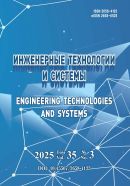DOI: 10.15507/2658-4123.034.202404.584-596
Additive Technologies for Production and Repair of Agricultural Equipment
Petr V. Senin
Dr.Sci. (Eng.), Professor of the Department of Technical Service of Machines, National Research Mordovia State University (68 Bolshevistskaya St., Saransk 430005, Russian Federation), ORCID: https://orcid.org/0000-0003-3400-7780, Researcher ID: H-1219-2016, SPIN-code: 3197-5080, This email address is being protected from spambots. You need JavaScript enabled to view it.
Mikhail N. Chatkin
Dr.Sci. (Eng.), Professor of Prof. Leshchankin Chair of Mobile Power Tools and Agricultural Machinery, National Research Mordovia State University (68 Bolshevistskaya St., Saransk 430005, Russian Federation), ORCID: https://orcid.org/0000-0002-3758-7066, SPIN-code: 3600-3720, This email address is being protected from spambots. You need JavaScript enabled to view it.
Eugen A. Kilmyshkin
Cand.Sci. (Eng.), Associate Professor of Prof. Leshchankin Chair of Mobile Power Tools and Agricultural Machinery, National Research Mordovia State University (68 Bolshevistskaya St., Saransk 430005, Russian Federation), ORCID: https://orcid.org/0000-0002-4827-8277, Researcher ID: CAF-9821-2022, SPIN-code: 6497-0730, This email address is being protected from spambots. You need JavaScript enabled to view it.
Abstract
Introduction. The article raises the issue of repairing modern agricultural machinery. Because of increasing the complexity of the design of machine components, there is a problem of failure of their parts. Manufacturers often do not sell these parts separately that makes it impossible to repair failed machine components. In this case, the purchase of a machine component assembly is required. The problem of supplying service parts is very significant. This significantly increases the repair time that negatively affects the agricultural production profitability due to the extremely limited time for farming operations. A solution to the issue of supplying service parts, reducing the cost of repairs and breakdown time is in the independent production of parts using additive technologies.
Aim of the Study. The study is aimed at examining the complete cycle of additive manufacturing using 3D scanning, 3D printing, and vacuum casting in silicone molds to reduce the renovation cost of technical equipment for agriculture.
Materials and Methods. Additive manufacturing is a technology for creating threedimensional objects through layer-by-layer building. In this technology, there are used a computer, 3D printer and 3D scanner. The 3D printer, based on the CAM model data, distributes the material on the construction surface, and through various sintering or melting technologies, gives the shape of the future part. A 3D scanner allows creating a threedimensional model of the finished product for subsequent improvement, modernization, expansion or simply copying with the possibility of subsequent printing. In addition to the production of parts by 3D printing, vacuum casting of polymers into silicone molds is very popular. This technology can use prototypes printed on a 3D printer or obtained using a classical production method as a master model.
Results. To study the state of the issue, we have used research materials of the Design and Rapid Prototyping Technology Center “RAPID-PRO” of the National Research N.P. Ogarev Mordovia State University. Analyzing the statistical data over the past 5 years, we have concluded that the demand for all types of work in the additive manufacturing cycle has recently become urgent. There is a trend of increasing demand for 3D scanning and reverse engineering services.
Discussion and Conclusion. The use of additive technologies makes it possible to produce quickly the parts of any complexity and therefore to reduce significantly the time for scientific research and design. At scientific, educational and industrial institutions special sectors, there should be created areas and centers, equipped for working in the field of additive manufacturing. However, the lack of trained personnel, the lack of basic knowledge about additive technologies and skills in using the equipment significantly reduces the speed of implementation of these technologies at the repair facilities of the agricultural sector and requires retraining and training of specialists.
Keywords: 3D printing, 3D scanning, reverse engineering, additive technology, casting
Conflict of interest: The authors declare no conflict of interest.
Acknowledgments: The authors would like to thank the external participants who made significant contributions to the study.
For citation: Senin P.V., Chatkin M.N., Kilmyashkin E.A. Additive Technologies for Production and Repair of Agricultural Equipment. Engineering Technologies and Systems. 2024;34(4):584–596. https://doi.org/10.15507/2658-4123.034.202404.584-596
Authors contribution:
P. V. Senin – formulation of research objectives, general management.
M. N. Chatkin – general management, formulation of conclusions.
E. A. Kilmyashkin – theoretical analysis, formulation of conclusions.
All authors have read and approved the final manuscript.
Submitted 24.07.2024;
revised 16.08.2024;
accepted 23.08.2024
REFERENCES
1. Litunov S.N., Slobodenyuk V.S., Melnikov D.V. [Review and Analysis of Additive Technologies. Part 1]. Omsk Scientific Bulletin. 2016;1(145):12–17. (In Russ.) Available at: https://clck.ru/3DXM4T (accessed 26.06.2024).
2. Katkar R.A. Taft R.M., Grant G.T. 3D Volume Rendering and 3D Printing (Additive Manufacturing). Dental Clinics of North America. 2018;62(3):393–402. https://doi.org/10.1016/j.cden.2018.03.003
3. Mal’tseva O.V. World Market Development for 3D Printers. Russian Foreign Economic Journal. 2018;9:88–97. (In Russ., abstract in Eng.) Available at: https://journal.vavt.ru/rfej/article/view/1610 (accessed 17.06.2024).
4. Ning F., Cong W., Qiu J., Wei J., Wang S. Additive Manufacturing of Carbon Fiber Reinforced Thermoplastic Composites Using Fused Deposition Modeling. Composites Part B: Engineering. 2015;80:369–378. https://doi.org/10.1016/j.compositesb.2015.06.013
5. Ngo T.D., Kashani A., Imbalzano G., Nguyen K.T.Q., Hui D. Additive Manufacturing (3D Printing): A Review of Materials, Methods, Applications and Challenges. Composites Part B: Engineering. 2018;143:172–196. https://doi.org/10.1016/j.compositesb.2015.06.013
6. Mohsen A. The Rise of 3-D Printing: The Advantages of Additive Manufacturing Overtraditional Manufacturing. Business Horizons. 2017;60(5):677–688. https://doi.org/10.1016/j.compositesb.2015.06.013
7. Golubev I.G., Bykov V.V., Golubev M.I., Spitsyn I.A. Analysis of Additive Equipment for 3D Printing of Parts. Technical Servis of Cars. 2019;1(134):194–200. (In Russ., abstract in Eng.) EDN: ZCGKHB
8. Suryatal B.K., Sarawade S.S., Deshmukh S.P. Fabrication of Medium Scale 3D Components Using Stereolithography System for Rapid Prototyping. Journal of King Saud Univercity – Engineering Sciences. 2023;35(1):40–52. https://doi.org/10.1016/j.jksues.2021.02.012
9. Ch.-Ch. Kuo, Y.-R. Chen Rapid Optical Inspection of Bubbles in the Silicone Rubber. Optik – International Journal for Light and Electron Optics. 2013;124(13):1480–1485.
10. Antypas I.R., Dyachenko A.G. Modeling, Studying and Manufacturing a Cultivator Rack from Composite Materials. Mordovia University Bulletin. 2018;28(3):366–378. (In Russ., abstract in Eng.) https://doi.org/10.15507/0236-2910.028.201803.366-378
11. Karande A.M., Kalbande D.R. Weight Assignment Algorithms for Designing Fully Connected Neural Networks. International Journal of Intelligent Systems and Applications. 2018;10(6):68–76. https://doi.org/10.5815/ijisa.2018.06.08
12. Sanatgar R.H., Campagne C., Nierstrasz V. Investigation of the Adhesion Properties of Direct 3D Printing of Polymers and Nanocomposites on Textiles: Effect of FDM Printing Process Parameters. Applied Surface Science. 2017;403:551–563. https://doi.org/10.1016/j.apsusc.2017.01.112
13. Dev S., Srivastava R. Experimental Investigation and Optimization of FDM Process Parameters for Material and Mechanical Strength. Materials Today: Proceedings. 2020;26(2):1995–1999. https://doi.org/10.1016/j.matpr.2020.02.435
14. Golubev I.G., Spitsyn I.A., Bykov V.V., Golubev M.I. Prospects of Application of Additive Technologies in the Repair of Agricultural Machinery. Proceedings of GOSNITI. 2018;130:214–219. (In Russ., abstract in Eng.) EDN: YVGNHL
15. Ahmad A., Darmoul S., Ameen W., Abidi M.H., Al-Ahmari A.M. Rapid Prototyping for Assembly Training and Validation. IFAC-PapersOnLine. 2015;48(3):412–417. https://doi.org/10.1016/j.ifacol.2015.06.116
16. Nefelov I.S. [Restoration of Worn-Out Machine Parts Using Additional Repair Parts Manufactured Using Additive Technologies]. Repair, Restoration, Modernization. 2018;11:15–17. (In Russ.) https://doi.org/10.31044/1684-2561-2018-0-11-15-17
17. Skorokhodov D.M. Determinants of Quality Control Accuracy of Automated Measuring Device for Spare Parts of Agricultural Machinery. Agricultural Engineering (Moscow). 2018;2(84):44–49. (In Russ., abstract in Eng.) https://doi.org/10.26897/1728-7936-2018-2-44-49
18. Ovchinnikov V.A., Kilmyashkin E.A., Knyazkov A.S., Ovchinnikova A.V., Zhalnin N.A., Zykin E.S. Development of an Adaptive Centrifugal Working Tool for Mineral Fertilization Using Rapid Prototyping Technologies. Engineering Technologies and Systems. 2022;32(2):222‒234. (In Russ., abstract in Eng.) https://doi.org/10.15507/2658-4123.032.202202.222-234

This work is licensed under a Creative Commons Attribution 4.0 License.

















